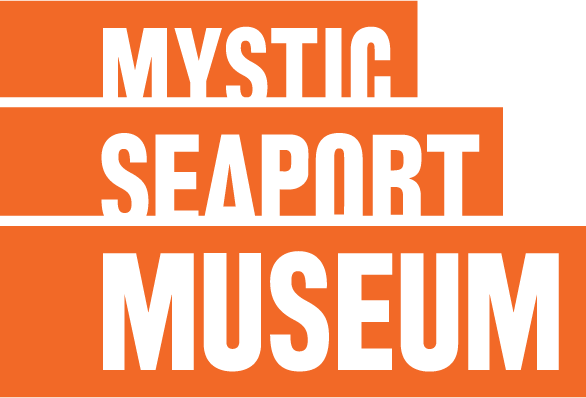Throughout the Mystic Seaport Museum’s 19 acres you will find a diverse collection of gardens, trees, and shrubs which are labeled indicating both the common and botanical name. Our gardens contain hundreds of different varieties of plants that accentuate the beauty and historical context of the Mystic River, ships, and 19th-century village.
The Museum’s gardens are educational tools used to create interest in plants and gardening. They are designed to motivate and excite visitors about horticultural history and our heritage as New England gardeners.
Mystic Seaport Museum has re-created two 19th-century gardens, the Burrows House garden and the Buckingham-Hall House garden, that portray the social order, economy, and cultural pursuits brought about by the Industrial Age. Most plants used are heirloom varieties, many of which are popular today. Additional gardens can be found throughout Museum grounds, including a Children’s Zoo garden featuring plants with fun names—like elephant ear plants—to appeal to future gardeners.
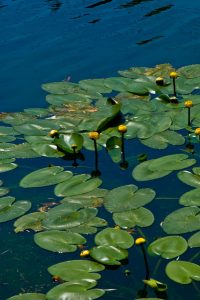 The pond next to the Museum’s North Parking Lot may not look special, but it is especially significant. During the redesign of its parking lots, Mystic Seaport redesigned the adjoining wetlands. Opposite the main entrance, a small tidal marsh was rebuilt with plantings native to Connecticut salt marshes. This freshwater pond covers part of the site of a pasture pond in Greenmanville. It has been reshaped and replanted with native species to filter the storm water that runs off the nearby mill roof and parking lot, delivering clean water to the Mystic River. From bacteria to birds, it has become a little preserve of local nature. In summer you may see a “fountain” in the pond, which is an aerator to ensure that the water is well oxygenated so the pond can perform its purifying function.
The pond next to the Museum’s North Parking Lot may not look special, but it is especially significant. During the redesign of its parking lots, Mystic Seaport redesigned the adjoining wetlands. Opposite the main entrance, a small tidal marsh was rebuilt with plantings native to Connecticut salt marshes. This freshwater pond covers part of the site of a pasture pond in Greenmanville. It has been reshaped and replanted with native species to filter the storm water that runs off the nearby mill roof and parking lot, delivering clean water to the Mystic River. From bacteria to birds, it has become a little preserve of local nature. In summer you may see a “fountain” in the pond, which is an aerator to ensure that the water is well oxygenated so the pond can perform its purifying function.
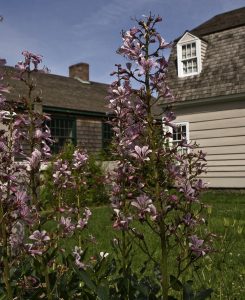 Burrows House during the 1860s and 1870s, was typical of working-class citizens living in a waterfront village. The Industrial Revolution brought about many changes that affected life in America, including gardening activities. The availability of manufactured garden equipment, exotic plant materials coming in from all over the world, and more leisure time all contributed to the shift in gardening practices.
Burrows House during the 1860s and 1870s, was typical of working-class citizens living in a waterfront village. The Industrial Revolution brought about many changes that affected life in America, including gardening activities. The availability of manufactured garden equipment, exotic plant materials coming in from all over the world, and more leisure time all contributed to the shift in gardening practices.
New England gardens were no longer needed solely for utilitarian purposes. There was no longer a need for large fields of crops, such as corn. Large gardens packed with produce were replaced with smaller vegetable and flower gardens. Flower gardens were no longer just for the very wealthy people. The art of home flower gardening was born!
Let us go back to the Burrows family. Among the many financial difficulties and health woes that Mrs. Burrows is enduring she has to figure out how to use her new gardening tools.
Sweet Autumn Clematis (Clematis paniculata):
Native to Japan, this late blooming climber is breathtaking. With a sweet smell, almost akin to almond, Clematis can surely please.
Evening Primrose (Oenothera missourensis)
Originally found in South Central United States, this vigorous perennial has a trailing habit.
Love-in-a-Mist (Nigella damascena)
This is a unique flower from southern Europe that offers texture and color. Love-in-a-Mist has papery-textured flowers with wiry foliage. Both flowers and seed pods are great in cut flower or dried arrangements.
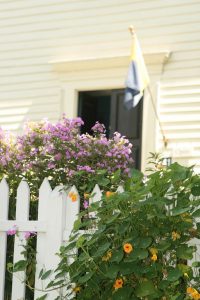 The gardens at the Buckingham-Hall House are a representation of the Hall family’s coastal homestead in the mid-1830s. This pre-industrial family subsisted on large gardens filled with vegetables, herbs, fruits, and flowers. The family would use their produce in making food, dying textiles, and creating remedies throughout the year.
The gardens at the Buckingham-Hall House are a representation of the Hall family’s coastal homestead in the mid-1830s. This pre-industrial family subsisted on large gardens filled with vegetables, herbs, fruits, and flowers. The family would use their produce in making food, dying textiles, and creating remedies throughout the year.
With practicality in mind, the Hall family had a site-specific layout of the gardens, meeting the needs of the plants and the family. Each garden is placed according to sun exposure, soil conditions, proximity to kitchen, and water supplies.
New England in the 1830s was a self-sufficient time. The Halls relied heavily on the collection of seeds to plant for the next season. Using the seeds from plants that performed well, the garden had a greater resistance to pests, climatic extremes, and disease. This is much of what we strive for today: high yielding crops and a less expensive production.
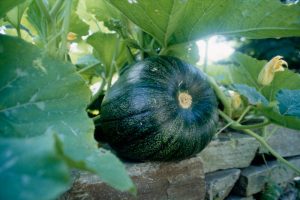 The Kitchen Garden
The Kitchen Garden
The Buckingham-Hall House kitchen garden is filled with vegetables and herbs. We practice horticultural methods with crop rotation and use horse manure, and also mulch with salt marsh hay and when available, seaweed. The produce grown in this garden is used in the Buckingham-Hall House cooking demonstrations and in the Children’s Museum’s programs.
Parlor Garden
The parlor garden welcomes visitors with bright heirloom annuals and perennials. This is the garden commonly seen from the parlor room and the area is designed for pleasure and utility. The parlor garden contains a number of show-stopping flowers and herbs, including:
Balsam, Touch-Me-Not (Impatiens balsamina)
This annual has pink rose-like flowers that bloom from early summer to fall. The name Touch-Me-Not was given due to the nature of the seed pods. When touched, balsam’s ripe seed pods burst, flinging the seed away from the plant.
Nasturtium (Tropaeolum majus)
Nasturtium is a true beauty in the garden. This climber has beautiful blooms from summer to frost. Along with attracting butterflies and hummingbirds, this plant is edible. The leaves can be used as greens for salad.
The Fruit Yard
The fruit yard was a vital garden for the Halls; much of the produce grown here was consumed or made into jellies, jams, pies, or cider.
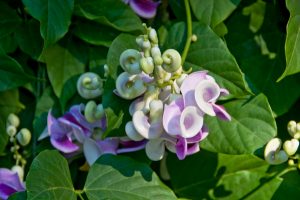 Located at the Children’s Museum, this colorful garden is planted with annuals, perennials, and a few small shrubs and trees. Each of the plants has an animal or insect in its common name such as dogwood, elephant ears, butterfly bush, snail flower, and turtlehead. Many of the plants also play with the senses, such as the soft, fuzzy lamb’s ears or the cat mint’s fragrant foliage.
Located at the Children’s Museum, this colorful garden is planted with annuals, perennials, and a few small shrubs and trees. Each of the plants has an animal or insect in its common name such as dogwood, elephant ears, butterfly bush, snail flower, and turtlehead. Many of the plants also play with the senses, such as the soft, fuzzy lamb’s ears or the cat mint’s fragrant foliage.
When you enter our Zoo Garden you will find many flowers. One flower that we love is the Snail Flower (Phaseolus caracalla). This flower looks like a bunch of pink and purple snails and its scent is very fragrant, like baby powder.
The Snail Flower is a plant from South America. Many of the plants that gardeners love are from areas that are far away. In history, people bring plants with them when they move. Sometimes people would bring plants on boats or by foot.
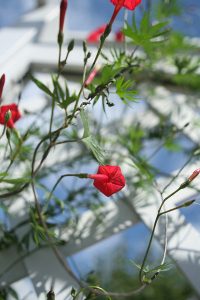 Native Plants
Native Plants
There are many plants in the Children’s Zoo garden that are native to New England. Native plants are in their natural environment and learn how to grow in an area without the help of people. Some native plants in this garden include:
Beebalm (Monarda didyma)
Beebalm is a native New England plant that has deep red flowers. Bees love the smell of the flowers, and because of this, Beebalm is very often covered in bees! There is a bird that loves Beebalm as well, can you think of which it is?
Turtlehead (Chelone lyonii)
Turtlehead is another native plant in our Zoo garden. Its purple flowers look like an open-mouthed turtle. Turtleheads are plants that like to grow near streams and ponds. Can you see why it is named Turtlehead?
Crabgrass, are you a weed?
Crabgrass is welcome in the Zoo Garden. This plant is very strong and grows fast by putting roots out all over the ground. These roots soak up all the nutrients or food that other plants use to grow.
Crabgrass is a friend in the Zoo garden because of its name, however, in any other garden it is an enemy. Since crabgrass grows very fast and strong it is called a weed. Weeds are plants that are unwanted by the gardener, but also by other plants. They compete and fight with other plants to take over their space and soak up all the nutrients. Crabgrass, don’t leave the Zoo Garden!
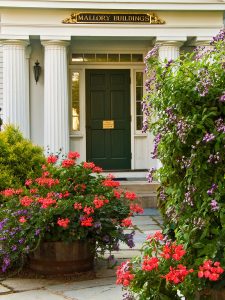 Sprigs & Twigs, Inc., the Museum’s official landscape company, designed the Mallory Birds & Butterflies Garden, which is located in front of the Mallory Building. This garden has glorious color and is inviting to butterflies and hummingbirds.
Sprigs & Twigs, Inc., the Museum’s official landscape company, designed the Mallory Birds & Butterflies Garden, which is located in front of the Mallory Building. This garden has glorious color and is inviting to butterflies and hummingbirds.
Garden made possible by:

Located behind the Treworgy Planetarium, the Memorial Garden was created to honor those who have given their time and resources to Mystic Seaport Museum. In a partly shaded area with subdued colors, the tone of the garden is peaceful and private.
This garden is designed as a perennial border keyed to low maintenance and a palette of soft colors. Plants were chosen for their foliage, forms, and color; their resistance to disease and pests; and their long blooming season.
The Memorial Garden is filled with modern varieties of plants that catch the eyes of Museum visitors. The following are examples that create a whimsical yet calming texture within the garden.
Meadow Rue (Thalictrum aquilegifolium)
An early blooming perennial, Meadow Rue fills the garden with delicate hints of pink. Growing 3-4 feet tall, this plant offers height and texture. In late spring, large airy panicles of pink tufted flowers emerge from the bluish-green, making an impressionistic scene.
Snakeroot (Cimicifuga racemosa)
This native plant towers in the garden offering unique color and texture. Snakeroot grows 3-8 feet tall and captivates with deep purple foliage and tall white plumes.
Japanese Anemone (Anemone japonica ssp.)
When the coastal breeze dances with these flowers the true beauty of the Anemone is seen. A late blooming perennial, each flower stem is up to 5 feet in length and stands proudly without much staking.


